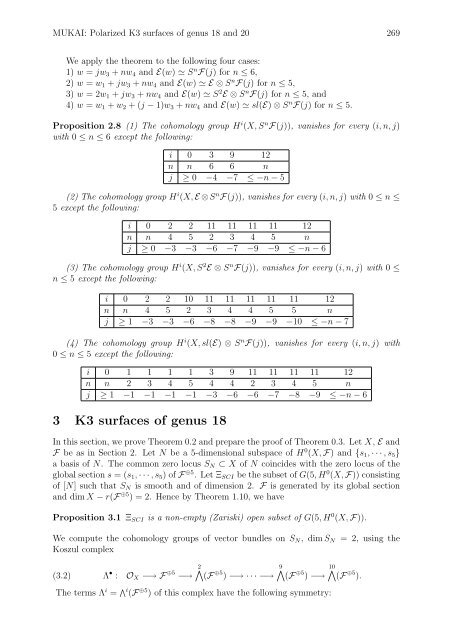Polarized K3 surfaces of genus 18 and 20 - Research Institute for ...
Polarized K3 surfaces of genus 18 and 20 - Research Institute for ...
Polarized K3 surfaces of genus 18 and 20 - Research Institute for ...
Create successful ePaper yourself
Turn your PDF publications into a flip-book with our unique Google optimized e-Paper software.
MUKAI: <strong>Polarized</strong> <strong>K3</strong> <strong>surfaces</strong> <strong>of</strong> <strong>genus</strong> <strong>18</strong> <strong>and</strong> <strong>20</strong> 269<br />
We apply the theorem to the following four cases:<br />
1) w = jw 3 + nw 4 <strong>and</strong> E(w) ≃ S n F(j) <strong>for</strong> n ≤ 6,<br />
2) w = w 1 + jw 3 + nw 4 <strong>and</strong> E(w) ≃ E ⊗ S n F(j) <strong>for</strong> n ≤ 5,<br />
3) w = 2w 1 + jw 3 + nw 4 <strong>and</strong> E(w) ≃ S 2 E ⊗ S n F(j) <strong>for</strong> n ≤ 5, <strong>and</strong><br />
4) w = w 1 + w 2 + (j − 1)w 3 + nw 4 <strong>and</strong> E(w) ≃ sl(E) ⊗ S n F(j) <strong>for</strong> n ≤ 5.<br />
Proposition 2.8 (1) The cohomology group H i (X, S n F(j)), vanishes <strong>for</strong> every (i, n, j)<br />
with 0 ≤ n ≤ 6 except the following:<br />
i 0 3 9 12<br />
n n 6 6 n<br />
j ≥ 0 −4 −7 ≤ −n − 5<br />
(2) The cohomology group H i (X, E ⊗S n F(j)), vanishes <strong>for</strong> every (i, n, j) with 0 ≤ n ≤<br />
5 except the following:<br />
i 0 2 2 11 11 11 11 12<br />
n n 4 5 2 3 4 5 n<br />
j ≥ 0 −3 −3 −6 −7 −9 −9 ≤ −n − 6<br />
(3) The cohomology group H i (X, S 2 E ⊗ S n F(j)), vanishes <strong>for</strong> every (i, n, j) with 0 ≤<br />
n ≤ 5 except the following:<br />
i 0 2 2 10 11 11 11 11 11 12<br />
n n 4 5 2 3 4 4 5 5 n<br />
j ≥ 1 −3 −3 −6 −8 −8 −9 −9 −10 ≤ −n − 7<br />
(4) The cohomology group H i (X, sl(E) ⊗ S n F(j)), vanishes <strong>for</strong> every (i, n, j) with<br />
0 ≤ n ≤ 5 except the following:<br />
i 0 1 1 1 1 3 9 11 11 11 11 12<br />
n n 2 3 4 5 4 4 2 3 4 5 n<br />
j ≥ 1 −1 −1 −1 −1 −3 −6 −6 −7 −8 −9 ≤ −n − 6<br />
3 <strong>K3</strong> <strong>surfaces</strong> <strong>of</strong> <strong>genus</strong> <strong>18</strong><br />
In this section, we prove Theorem 0.2 <strong>and</strong> prepare the pro<strong>of</strong> <strong>of</strong> Theorem 0.3. Let X, E <strong>and</strong><br />
F be as in Section 2. Let N be a 5-dimensional subspace <strong>of</strong> H 0 (X, F) <strong>and</strong> {s 1 , · · · , s 5 }<br />
a basis <strong>of</strong> N. The common zero locus S N ⊂ X <strong>of</strong> N coincides with the zero locus <strong>of</strong> the<br />
global section s = (s 1 , · · · , s 5 ) <strong>of</strong> F ⊕5 . Let Ξ SCI be the subset <strong>of</strong> G(5, H 0 (X, F)) consisting<br />
<strong>of</strong> [N] such that S N is smooth <strong>and</strong> <strong>of</strong> dimension 2. F is generated by its global section<br />
<strong>and</strong> dim X − r(F ⊕5 ) = 2. Hence by Theorem 1.10, we have<br />
Proposition 3.1 Ξ SCI is a non-empty (Zariski) open subset <strong>of</strong> G(5, H 0 (X, F)).<br />
We compute the cohomology groups <strong>of</strong> vector bundles on S N , dim S N<br />
Koszul complex<br />
= 2, using the<br />
2∧ 9∧ 10∧<br />
(3.2) Λ • : O X −→ F ⊕5 −→ (F ⊕5 ) −→ · · · −→ (F ⊕5 ) −→ (F ⊕5 ).<br />
The terms Λ i = ∧i (F ⊕5 ) <strong>of</strong> this complex have the following symmetry:
















